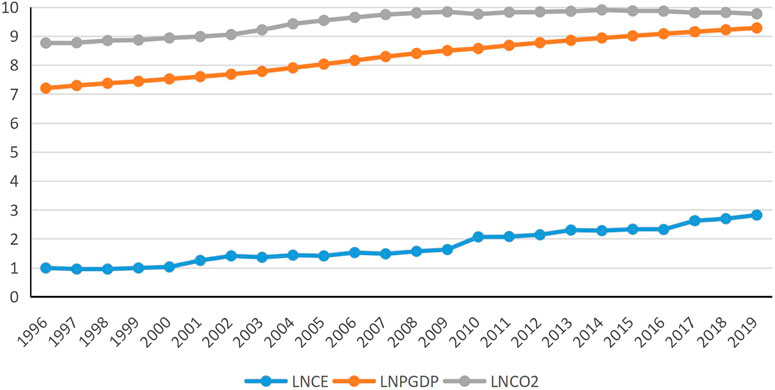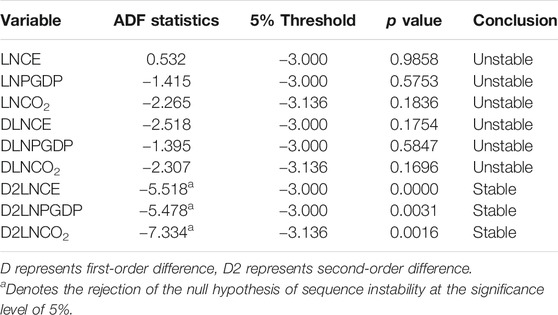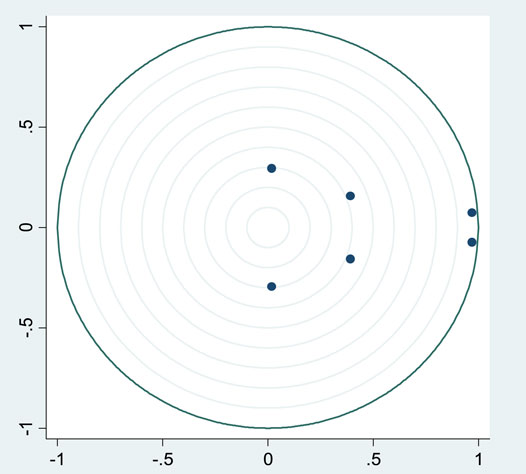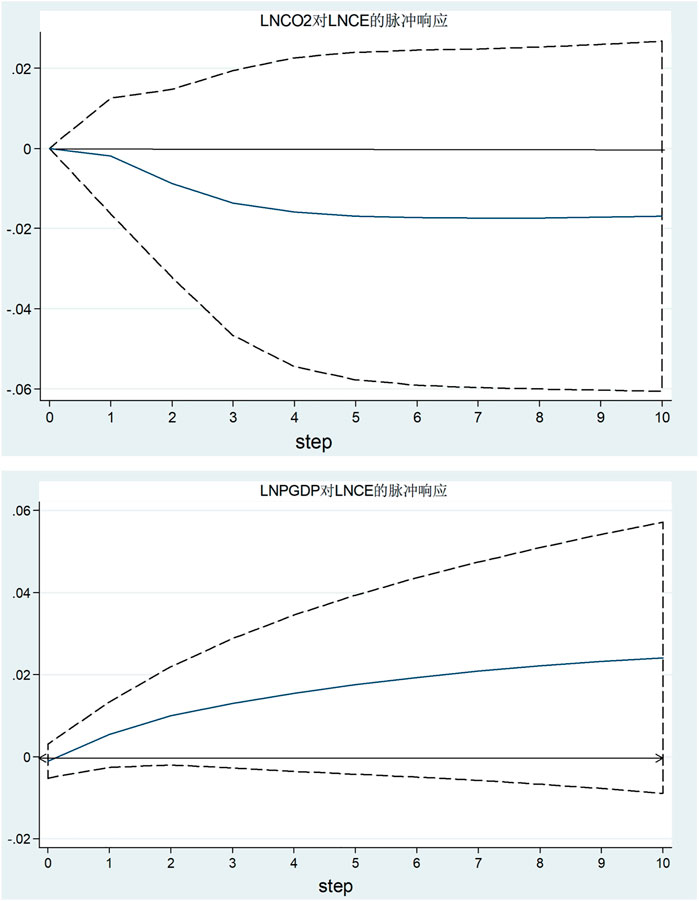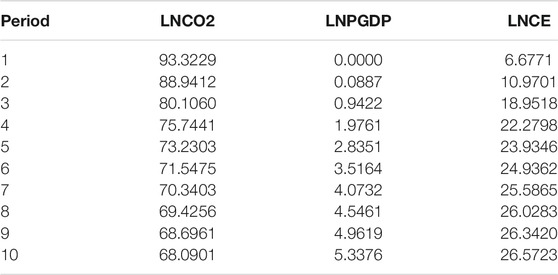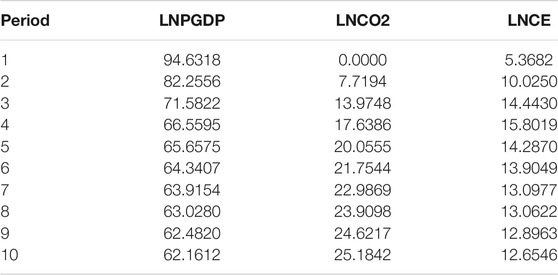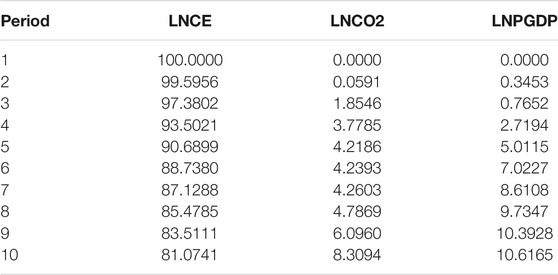- 1Institute of Guangdong Economy and Social Development, Guangdong University of Finance and Economics, Guangzhou, China
- 2Guangdong Provincial Key Laboratory of Public Finance and Taxation with Big Data Application, Guangdong University of Finance and Economics, Guangzhou, China
This article takes Henan Province as the research object and analyzes the relationship between the green energy use, carbon emissions and economic growth in Henan Province by constructing a VAR model. The results show that: 1) There is a long-term equilibrium relationship between the green energy use, carbon emissions and economic growth in Henan Province. The green energy use can simultaneously promote the reduction of carbon dioxide emissions and sustainable growth of economy; 2)The article examines the “creative” effect and “destructive” effect of green energy use on economic structure in Henan Province, and the “creative” effect is greater than the “destructive” effect, so, the green energy use can help Henan Province to achieve green and low-carbon economic growth; 3) Carbon dioxide emission and economic growth are the important factors affecting the green use of energy in Henan Province. Recently, the call of national carbon emission reduction and the pressure of economic development transition have induced Henan Province to change to a clean and green use of energy to some extent; 4) The contribution rate of green energy use to economic growth shows an inverted U-shaped trend, which increases first and then decreases. Carbon emission has influence on both green energy use and economic growth to a certain degree. Finally, targeted recommendations are presented to promote the green energy use and ensure the coordinated and sustainable development of economy and environment of Henan Province.
Introduction
Since the reform and opening up, Henan has witnessed rapid economic development. The province’s GDP has exceeded 5 trillion yuan, and the per capita GDP has exceeded 8,000 US dollars. However, its rapid economic development relies heavily on the input and use of fossil energy such as coal. In 2019, the total energy consumption of the province exceeded 22,000 tons of standard coal, with coal accounting for 67.4%. And before 2019, the energy coal accounted for more than 69%. The massive investment and use of energy, especially coal, has promoted the rapid economic development, but it has also led to serious environmental pollution and the emission of a large amount of greenhouse gases such as CO2, which has brought enormous pressure to the environmental governance and carbon emission reduction of Henan Province.
Energy is the cornerstone and pillar of economic development. A large amount of energy investment has promoted the rapid growth of regional economy, but it has led to a large number of greenhouse gas emissions such as CO2 and serious ecological environmental problems, which in turn will affect the economic development. The “Fourteenth Five-Year Plan for National Economic and Social Development of Henan Province and the Outline of the 2035 Long-Term Goals (Draft)” hereinafter referred to as the “Draft Outline,” puts forward the goal of building an ecologically strong province. It points out that we shall form a green way of production and life. And at the same time the carbon emissions shall reach a peak after a steady decline. Meanwhile the man and nature basically realize the modernization of harmonious coexistence. Low-carbon and green have become the keynote of Henan’s economic development. Under this background, the green energy use has become an important measure of carbon emission reduction in Henan Province.
The green energy use can reduce the emission of greenhouse gases such as CO2, but the economic growth of Henan Province is heavily dependent on traditional energy sources such as coal. Therefore, how to rationally arrange the green energy use in the balance between carbon emission reduction and economic growth has become an important research issue. Schumpeter pointed out that “creative destruction” of economic structure is the fundamental driving force of economic growth and the essence of innovation. Green energy use in Henan Province will have a significant impact on the original economic structure of Henan Province: On the one hand, green energy use will have a negative impact on traditional energy production and processing industries with high energy consumption, high pollution and high emission, such as coal, oil and other traditional manufacturing industries, resulting in a “destructive” effect on economic development and growth. However, green energy use will also promote the rise and development of clean energy production and use industries such as new energy batteries, new energy automobiles and other industries, which will bring new sources of growth to economic growth, namely the “creative” effect. Therefore, it is necessary to comprehensively evaluate whether the green energy use in Henan promotes or hinders the economic growth and development of Henan Province. Only when the “creative” effect of the green energy use is greater than the “destructive” effect, the green energy use in Henan Province can be an important measure conducive to the high-quality development of Henan Province.
The outline of the “14th Five-Year Plan” focuses on accelerating the green transformation of development methods, and synergistically promoting high-quality economic development and high-level protection of the ecological environment. The coordinated development of green, low-carbon and high- quality has become the overall background of economic growth. Under the background of national advocacy, it is important for Henan Province to find the balance between the green energy use, carbon emission reduction and economic growth to ensure the coordinated and sustainable development of economy and environment.
Accordingly, in order to study the relationship between the green energy use, carbon emission reduction and economic growth in Henan Province, this article will construct a vector autoregressive (VAR) model to analyze how green energy use can achieve a balance between carbon emission reduction and economic growth. At the same time, the article will further examine whether the requirements of carbon emission reduction and economic growth can promote and induced the green energy use.
The contributions of this paper lie in five aspects: first, it fills the gap in the research on the relationship between the green energy use, carbon emissions and economic growth in Henan Province. Second, it finds out that how the green energy use can achieve a balance between carbon emission reduction and economic growth. Third, it examines the “creative” effect and “destructive” effect of green energy use on economic structure in Henan Province, and provides theoretical support for green energy use in Henan Province. Fourth, it analyzes the effect of green energy use on the economic growth of Henan Province, which provides a reference for the energy development and reform of other countries and regions like Henan Province. Finally, the paper provides relevant countermeasures and suggestions for the green energy use in Henan Province, which has a certain significance for the energy reform in Henan Province.
The rest of this article is structured as follows: Literature review is provided in “Literature review” section. The Research design is established in the “Research design” section, where data source, data processing and model design, are introduced. The results are discussed in the “Empirical analysis” section. In this section, we analyze the relationship between the green energy use, carbon emissions and economic growth in Henan Province. The “Discussion” section shows implications of research results for developing countries and regions. Conclusions and recommendations are drawn in the final section.
Literature Review
Whether green energy use can reduce carbon emissions, most scholars believe that the relationship between the two is positive: for example Fei et al. (2014) conducted research on energy use in Norway and New Zealand and found that clean energy input can help reduce carbon dioxide emissions. Shafiei and Salim (2014) believes that the increase in renewable energy consumption will help reduce carbon dioxide emissions. Dogan and Seker (2016) pointed out that the green use of energy can reduce carbon dioxide emissions. Zoundi (2017) believes that the increase in renewable energy consumption will negatively affect carbon dioxide emissions. Feng and Zou (2008) believe that low-carbon energy structure can positively drive carbon dioxide emissions reduction. Lu et al. (2013) pointed out that greener use of energy structure can restrict carbon dioxide emissions. Zou et al. (2021) pointed out that solar energy, wind energy, hydro energy, nuclear energy and hydrogen energy are the main force of new energy, which will help the power sector to achieve low carbon emissions. “Green hydrogen” is the backup of new energy, helping to further reduce carbon emissions in industrial and transportation sectors.
There is no unified conclusion on the relationship between green energy use and economic growth. Some scholars believe that green energy use will promote economic growth: for instance Apergis and Payne (2012) and Inglesi-Lotz (2016) believe that the increase in renewable energy consumption has promoted positive economic growth. Pao et al. (2014) and Kahia et al. (2017) point out that there is a mutually reinforcing relationship between the use of renewable energy and economic growth. Cang et al. (2020) concluded that the economic growth rate supported by new energy is higher than that supported by traditional energy. Li and Xu (2020) found that renewable energy consumption plays an important role in stimulating economic growth through co-integration test and establishment of VECM model analysis. Xu (2021) pointed out that new energy demonstration cities are an institutional attempt of energy policy. The implementation of such policies has significantly promoted the growth of regional GDP and per capita GDP, and with the deepening of the policy, the effect becomes more significant. However, some scholars believe that the greening of energy use will negatively affect economic growth:for example Ocal and Aslan (2013) and Maji (2015) both believe that the consumption and use of renewable energy hinders economic growth. Qi and Li (2018) point out that the use of renewable energy consumption will have a negative impact on economic growth.
There is not much literature on the combination of green energy use, carbon emissions and economic growth in a unified framework for research: Wang (2020) conducted an empirical study on the relationship between green energy use, carbon emissions and economic growth by establishing a vector autoregressive model (VAR).
The research showed that there is a long-term equilibrium relationship between green energy use, carbon emissions and economic growth in our country. The green energy use not only reduces carbon dioxide emissions but also promotes sustainable economic growth in our country.
In reviewing the relevant literature, it can be found that, in recent years, there is almost no relevant research on the combination of green energy use, carbon emission and economic growth in Henan Province, which relies heavily on traditional fossil energy for economic development. Therefore, this article takes the relationship among the green energy use, carbon emissions and economic growth in Henan Province as the research object, which can fill this gap in the literature. At the same time, it analyzes how the green energy use in Henan Province can achieve a balance between carbon emission reduction and economic growth, which is of great significance for the development of new energy, high-quality economic growth and high-level protection of the ecological environment in Henan Province.
Research Design
Data Source and Processing
Since this article focuses on the interaction mechanism between the green energy use, carbon emissions and economic growth in Henan Province, this article will take carbon emissions and economic growth as the dependent variables for the analysis, and green energy use as the independent variables to construct a research model. Among them, green energy consumption is measured by the proportion of natural gas, primary power and other energy consumption to total energy consumption, recorded as CE, carbon emissions are measured by the carbon emissions of Henan Province’s primary energy consumption, recorded as CO2, and the economic growth is measured by per capita GDP, recorded as PGDP.
This article selects the relevant data of Henan Province from 1996 to 2019 for analysis. In order to eliminate the impact of inflation, the per capita GDP is converted into constant prices based on 1996. The data related to energy and economic growth are from the 1997–2020 “Henan Statistical Yearbook,” and the carbon emissions data are from calculations. The specific calculation formula is as follows:
Since the energy consumption data in the current statistics has been converted into standard coal, it is necessary to convert these data into physical quantities again. For the physical amount of various primary energy consumption, we use the reciprocal of the coefficient of conversion of various types of energy into standard coal announced by the National Development and Reform Commission, that is, 1 ton of standard coal = 1.4 tons of coal = 0.7 tons of oil = 0.5883 tons of natural gas (Shang, 2011). The carbon emissions coefficients of coal, oil and natural gas (Energy Research Institute, National Development and Reform Commission, 2003) are shown in Table 1.
Therefore, the final carbon emission calculation formula is:
Among them,
In order to eliminate the heteroscedasticity problem that may exist in the data analysis process, the three time series data of CE, CO2, and PGDP are processed by logarithm, and they are recorded as LNCE, LNCO2, and LNPGDP respectively, as shown in Figure 1.
Figure 1 shows the change trend of LNCE, LNCO2 and LNPGDP, and it can be concluded that there are three stages in clean energy development in Henan Province: the gentle development stage is from 1996 to 2000, the slow development stage is from 2001 to 2009 and the rapid development stage is from 2010 to 2019. The proportion of clean energy in Henan Province increased from 3.1% in 1996 to 16.8% in 2019, indicating that Henan Province has made remarkable achievements in green energy consumption and energy structure optimization. It can also be seen from Figure 1 that although Henan Province’s carbon dioxide emissions have been increasing year by year, its growth rate has slowed down significantly after 2010, indicating that Henan’s industrial structure upgrade and energy consumption structure optimization and other related measures have achieved certain results and contribute to the decline in the growth rate of carbon emissions. In addition, Henan’s per capita GDP maintained a rapid growth trend from 1996 to 2019.
Model Design
The vector autoregressive model (VAR) can effectively predict and judge whether multiple groups of correlated time series variables will affect their future development. Therefore, this paper chooses the VAR model to study the impact of green energy use on carbon emissions and economic growth in Henan Province. The expression of VAR model is as follows:
Where,
The VAR model is expressed in matrix form as follows:
Empirical Analysis
The Unit Root Test
Before analyzing the VAR model, it is necessary to perform a unit root test on the data to avoid “false regression” and ensure the stability of the VAR model data. Therefore, this article chooses the ADF unit root test method to test the original logarithmic data LNCE, LNCO2 and LNPGDP for the stationarity. The specific test results are shown in Table 2.
According to Table 2, LNCE, LNCO2 and LNPGDP and their first-order difference are all non-stationary series at the significance level of 5%, but their second-order difference series are stationary series at the significance level of 5%, so it is a second-order single integral process.
Cointegration Test
Although the original sequence is not stationary, it is likely that there is a long-term equilibrium relationship between the original sequences. Therefore, this paper uses Johansen co-integration test to determine how many linearly independent co-integration vectors there are between the original sequences. The specific results are shown in Table 3.
The cointegration rank trace test (trace statistic) including the constant term and the time trend term shows that there is only one linearly independent cointegration vector (starred in Table 3). However the maximum eigenvalue test (max statistic) shows that the null hypothesis of “cointegration rank is 0” can be rejected at the 5% level, but the null hypothesis of “cointegration rank is 1” can not be rejected. Thus, the corresponding cointegration equation can be drawn as follows:
According to the co-integration Eq. 5, there is a long-term equilibrium relationship between the green energy use and carbon emissions and economic growth in Henan Province. From a long-term perspective, the green energy use in Henan Province can not only reduce carbon dioxide emissions in Henan Province, but also promote Economic growth in Henan Province. we can see that if the proportion of green energy use in Henan province is increased by 1%, the carbon dioxide emission can be reduced by 2.7658%, indicating that the implementation and efforts of Henan Province’s energy clean-up policies and projects such as “coal to gas” have effectively reduced carbon dioxide emissions. In addition, an increase in the proportion of green energy use in Henan Province by 1% can increase per capita GDP by 0.8319%. This shows that the green energy use in Henan Province has indeed promoted the economic growth and development of Henan Province, and at the same time, it also indicates that the win-win economic growth goal of environmental effect and economic benefit is achieved to a certain extent. Therefore, from the perspective of the long-term economic development planning of a province, the “creative” effect of the green energy use in Henan Province is greater than the “destructive” effect, and the green and low-carbon economic growth in Henan Province has been realized. In other words, the sustainable and coordinated development of economy and environment can be realized to some extent. Hence, in the long term, the green energy use is an important measure of energy conservation, emission reduction and sustainable development for Henan Province.
Granger Causality Test
The co-integration test has confirmed that there is a long-term equilibrium relationship between LNCE, LNCO2 and LNPGDP. In order to further determine the causality between the variables, this paper will conduct a Granger causality test on them, and the test results are shown in Table 4.
It can be seen from Table 4 that both carbon emissions and economic growth are Granger reasons for green energy use, and green energy use is not the Granger reason for carbon emissions and economic growth. It shows that the carbon emissions and economic growth of Henan Province have a great impact on the green energy use in Henan Province. Therefore, the increasing pressure of carbon emission reduction and the unsustainable extensive economic growth mode will force the change of energy use to clean, low-carbon and green in Henan Province.
Impulse Response Analysis
According to the stationary test and co-integration test, LNCO2, LNCE and LNPGDP are all second-order single integration processes, so the VAR model can be constructed. In order to estimate the VAR model, it is necessary to first determine the optimal lag period of the VAR model according to the information criteria. The specific results are shown in Table 5.
It can be seen from Table 5 that the optimal lag order of the VAR model is 2, so the VAR(2) model can be established. The coefficient matrix estimation results are as follows:
If an effective impulse response analysis is to be carried out, the stability of the VAR model must be ensured. Therefore, the VAR model needs to be tested for stability before impulse response analysis. The test results are shown in Figure 2.
As can be seen from Figure 2, all eigenvalues of the model are within the unit circle, so the VAR model is stable and can be analyzed by impulse response analysis and variance decomposition analysis.
Figure 3 is a graph of the impulse response of LNCO2 and LNPGDP to LNCE. In Figure 3, the vertical axis is the value of the relevant response, and the horizontal axis is the period setting. This article is set to 10 periods.
It can be seen from Figure 3 that after a positive impact on green energy use, it will lead to a reduction in carbon dioxide emissions and an increase in per capita GDP. The green energy use will continue to negatively affect carbon dioxide emissions. At the same time, it maintains a positive impact on per capita GDP, which indicates that the green energy use in Henan Province can effectively reduce carbon dioxide emissions. Therefore, green energy use is an important measure for carbon emission reduction in Henan Province.
Variance Decomposition Analysis
After the impulse response analysis, the variance decomposition analysis can observe the contribution rate of the green energy use, carbon dioxide emissions and economic growth in Henan Province to the changes of the three variables. Table 6 shows the variance decomposition results of carbon dioxide emissions, and Table 7 shows The results of the variance decomposition of economic growth, Table 8 shows the results of the variance decomposition of green energy use, and the time is set to 10 periods.
It can be seen from Table 6 that carbon dioxide emissions are mainly affected by itself and the green energy use. Until the 10th period, the influence of the two remained above 94.7%. The contribution rate of economic growth to carbon dioxide emissions has also continued to increase and the influence reached 5.3376% in the 10th period. As can be seen from Table 7, economic growth is mainly influenced by itself, followed by carbon dioxide emissions. The contribution rate of green energy use to economic growth shows an inverted U-shaped trend that first rises and then falls, indicating that the impact of green energy use on economic growth increases first and then decreases. The data in Table 8 shows that the green energy use is mainly affected by itself, and its own contribution rate has been maintained at more than 81%. The impact of carbon emissions and economic growth on the green energy use is increasing, indicating that the continuous increase of carbon emissions in Henan Province, the pressure of emission reduction and the continuous growth of economy have promoted the clean and green energy use in Henan Province to some extent.
Discussion
Furthermore, our results suggest that there is a long-term equilibrium relationship between green energy use, carbon emissions, and economic growth for energy, especially coal-dependent developing regions. The article examines the “creative” effect and “destructive” effect of green energy use on economic structure in Henan Province, and the “creative” effect is greater than the “destructive” effect, that is to say the green and low-carbon economic growth in Henan Province has been realized, which provides a reference for the energy development and reform of other countries and regions like Henan Province.
For developing countries and regions like Henan Province with an average annual output value of about 5 trillion yuan, the green energy use will indeed promote carbon emission reduction and sustainable economic growth. Therefore, the green energy use is the progress of the economic development of developing countries and regions, and it is also the inevitable choice of developing countries and regions under the international call of “carbon neutral” and “carbon peak.”
The clean and green energy use can reduce carbon dioxide emissions and promote economic growth for developing energy-dependent countries and regions.
Therefore, when developing countries and regions are faced with the choice between carbon emission reduction and economic growth, the clean and green energy use is a major measure and method. The clean and green energy use can promote the optimization of energy structure and industrial structure in developing countries and regions. And it also can assist developing countries and regions to achieve high-quality economic development and high-level protection of the ecological environment. Hence, the clean and green energy use is imperative for developing countries and regions.
However, this article uses a regional data from Henan Province to conduct the research, and the regional samples are limited. This study will expand on this and select more regional samples to conduct research to verify the long-term equilibrium relationship between green energy use, carbon emissions, and economic growth. At the same time, this article also will find a balance between green energy use, carbon emission reduction and economic growth to ensure the coordinated and sustainable development of the economy and the environment.
Conclusions and Policy Recommendations
This paper takes Henan Province as the research object and analyzes the relationship between the green energy use, carbon emissions and economic growth in Henan Province by constructing a VAR model. The main conclusions are as follows:
1) There is a long-term equilibrium relationship between the green energy use, carbon emissions and economic growth in Henan Province. The co-integration equation also shows that the green energy use in Henan Province can simultaneously promote the reduction of carbon dioxide emissions and the sustainable growth of the economy. The acceleration of green energy use for Henan Province can ensure the realization of its win-win goals for energy conservation, emission reduction and sustainable economic development. Through impulse response analysis, we can still see that the green energy use is an important measure to achieve the carbon emission reduction and economic growth. This is mainly because the “creative” effect of green energy use in Henan Province on economic growth exceeds the “destructive” effect, and finally Henan Province has realized the green and low-carbon economic growth.
2) The Granger causality test shows that carbon dioxide emissions and economic growth are important factors affecting the green energy use in Henan Province. Recently, the call of national carbon emission reduction and the pressure of economic development and transformation have forced Henan Province to change its energy use to a cleaner and greener way to some extent. This is also an important reason for Henan Province to accelerate the optimization and transformation of industrial structure, accelerate the construction of energy saving and emission reduction industrial system and the construction of “coal to gas” project in recent years.
3) According to variance decomposition analysis, the contribution rate of green energy use to carbon dioxide and economic growth is between 5 and 27%, especially its contribution rate to economic growth shows an inverted U-shaped trend that increases first and then decreases. Carbon emissions have a certain influence on both green energy use and economic growth. However, its influence on economic growth is greater than its influence on the greening of energy use. However, although economic growth has a certain influence on the greening of energy use and carbon emissions, the influence is relatively small.
Based on the conclusion, this article proposes the following policy recommendations:
1) The promotion of green energy use in Henan Province is an important measure for Henan Province to reduce the pressure on the ecological environment and promote sustainable and healthy economic development. Therefore, it is suggested that Henan Province should focus on the dual effects of green energy use in reducing carbon emissions and promoting economic growth, and actively promote clean and green energy use in the province. At present, Henan Province ranks fifth in the national economic aggregate rankings. It is a large agricultural province and a populous province in the country. Economic development and employment stability are still the key goals of Henan Province in the future. Therefore, Henan Province can take the following measures in terms of energy transition and greening: In traditional energy-using industries (such as industry), we should promote their transformation to intelligence, accelerate the elimination of backward production capacity, actively introduce energy-saving and emission reduction green equipment, increase the proportion of investment in clean energy and renewable energy, and realize the green use of energy from the production side. For the clean energy production industry, the government should introduce corresponding policies and measures to ensure its construction and smooth production, and provide R&D tax credits and subsidies and other related measures to promote its rapid development to ensure the supply and use of clean energy in the province. For green industries such as new energy vehicles, the government should give strong policy and financial support, including subsidies and R&D tax incentives, to help enterprises go through the initial stage of smoothly promoting the development of green industries such as new energy. In addition, the whole province should pay attention to the construction and bidding of clean and green projects such as coal to gas to ensure the smooth implementation of green projects. Through the implementation of various measures related to energy greening, the process of energy greening and cleaning in Henan Province will continue to advance. After that a green and beautiful Henan will be realized as soon as possible, and the harmonious coexistence between man and nature will be truly realized.
2) The green energy use has forced Henan Province to optimize its energy use structure, which requires Henan Province to change its traditional energy consumption pattern. Its high dependence and high input on high-emission and high-polluting energy sources like coal should be gradually transformed. At the same time, the development and utilization of natural gas, hydropower, and nuclear energy should be accelerated. Henan Province also shall increase the proportion of clean energy in the province’s production and living inputs, and improve the peak shaving capacity of clean energy reserves to expand its utilization range. At the same time, we must also see that the economic development of Henan Province is highly dependent on coal. In the short term, its economic development will still require a large amount of coal energy input. Therefore, Henan Province should speed up the research and application of coal clean and green technologies. For example, coal water slurry technology, carbon storage technology and circulating fluidized bed combustion and other high-efficiency and clean coal combustion and conversion technologies. This can promote the transformation of coal, a black energy source, into a cleaner and greener one.
3) Improve the low-carbon and green-related laws of the energy market, and innovate the incentive system for low-carbon and green energy. Developed countries such as the United States and the United Kingdom have formed relatively complete energy low-carbon and green energy laws and regulations. However, although energy low-carbon and green energy has received certain attention and development in our country, there is still a long way to go. Henan Province’s laws and regulations on low-carbon and green energy have not formed a complete system. Therefore, Henan Province can consider expanding and detailing management measures for low-carbon and green energy use in industrial enterprises on the basis of the Ecological Environment Protection Law. For different types of industrial enterprises, different laws and regulations may be implemented. Henan Province needs to strengthen the regulatory mechanism for low-carbon and green development and operation of energy, and increase the employment rate of green industries. Henan Province can also innovate the incentive system for low-carbon and green use of energy, formulate incentive standards for green energy input and use, reward enterprises that meet the standards, set up good models, and drive the rapid transformation of energy use by enterprises in the province to green and clean energy.
4) Deepen the structural reform of the energy supply side, and give full play to the regulatory effect of the market mechanism in the energy market. With the vigorous development of green energy and green economy in Henan Province, the development of related industries will need a lot of financial support. Therefore, it is suggested that the government and financial institutions do a good job of green credit planning, make good use of green credit financial instruments, and give full play to their maximum effect, so as to meet the capital needs in the process of green energy use.
Data Availability Statement
Publicly available datasets were analyzed in this study. This data can be found here: Henan Statistical Yearbook.
Author Contributions
Y-lW conceived the idea and designed the model. Y-lW performed the mathematical studies and wrote the manuscript. She also critically screened the manuscript.
Funding
This work is supported by Open Foundation of Guangdong Provincial Key Laboratory of Public Finance and Taxation with Big Data Application.
Conflict of Interest
The author declares that the research was conducted in the absence of any commercial or financial relationships that could be construed as a potential conflict of interest.
References
Apergis, N., and Payne, J. E. (2012). Renewable and Non-renewable Energy Consumption-Growth Nexus: Evidence from a Panel Error Correction Model. Energ. Econ. 34 (3), 733–738. doi:10.1016/j.eneco.2011.04.007
Cang, D. b., Wei, X. p., Cao, M., and Tan, L. y. (2020). A Two-Stage Economic Growth Path Study Based on Energy Substitution and Environmental Pollution Control. Chin. Manag. Sci. 28 (9), 146–153. doi:10.16381/j.cnki.issn1003-207x.2020.09.015
Dogan, E., and Seker, F. (2016). Determinants of CO2 Emissions in the European Union: The Role of Renewable and Non-renewable Energy. Renew. Energ. 94, 429–439. doi:10.1016/j.renene.2016.03.078
Energy Research Institute “China Sustainable Development Energy and Carbon Emission Analysis” Research Group (2003). China Sustainable Development Energy and Carbon Emission Scenario Research. China Energy 6, 5–11.
Fei, Q., Rasiah, R., and Shen, L. J. (2014). The Clean Energy-Growth Nexus with CO2 Emissions and Technological Innovation in Norway and New Zealand. Energ. Environ. 25 (8), 1323–1344. doi:10.1260/0958-305x.25.8.1323
Feng, X., and Zou, J. (2008). Economic Analysis of CO2 Emission Trends in China. China Popul. Resour. Environ. 3, 43–47. doi:10.1016/S1872-583X(09)60005-X
Inglesi-Lotz, R. (2016). The Impact of Renewable Energy Consumption to Economic Growth: A Panel Data Application. Energ. Econ. 53, 58–63. doi:10.1016/j.eneco.2015.01.003
Kahia, M., Aïssa, M. S. B., and Lanouar, C. (2017). Renewable and Non-renewable Energy Use - Economic Growth Nexus: The Case of MENA Net Oil Importing Countries. Renew. Sustain. Energ. Rev. 71, 127–140. doi:10.1016/j.rser.2017.01.010
Li, P. y., and Xu, W. x. (2020). Empirical Analysis of China’s Renewable Energy Consumption and Economic Growth. Energ. Conservation Techn. 38 (4), 365–370.
Lu, W. B., Qiu, T. T., and Du, L. (2013). Research on the Influencing Factors of Carbon Emissions at Different Stages of Economic Growth in China. Econ. Res. 48 (4), 106–118.
Maji, I. K. (2015). Does Clean Energy Contribute to Economic Growth? Evidence from Nigeria. Energ. Rep. 1, 145–150. doi:10.1016/j.egyr.2015.06.001
Ocal, O., and Aslan, A. (2013). Renewable Energy Consumption-Economic Growth Nexus in Turkey. Renew. Sustain. Energ. Rev. 28, 494–499. doi:10.1016/j.rser.2013.08.036
Pao, H.-T., Li, Y.-Y., and Hsin-Chia Fu, H. C. (2014). Clean Energy, Non-clean Energy, and Economic Growth in the MIST Countries. Energy Policy 67, 932–942. doi:10.1016/j.enpol.2013.12.039
Qi, S. Z., and Li, Y. (2018). Threshold Effect of Renewable Energy Consumption on Economic Growth Under the Energy Transition. China Popul. Resour. Environ. 28 (2), 19–27.
Shafiei, S., and Salim, R. A. (2014). Non-renewable and Renewable Energy Consumption and CO2 Emissions in OECD Countries: a Comparative Analysis. Energ. Policy 66, 547–556. doi:10.1016/j.enpol.2013.10.064
Shang, W. Y. (2011). Research on the Evolution of Carbon Emissions from Energy Consumption in Henan Province and its Relationship with Economic Growth. Econ. fabric (3), 39–42. doi:10.15931/j.cnki.1006-1096.2011.03.005
Wang, S. (2020). Research on the Relationship Between Green Energy Use, Carbon Emissions and Economic Growth in China. Soft Sci. 34 (10), 7–11. doi:10.13956/j.ss.1001-8409.2020.10.02
Xu, H. G. (2021). New Energy Demonstration Cities and Regional Economic Growth. East China Econ. Manag. 35 (1), 71–85. doi:10.19629/j.cnki.34-1014/f.200404003
Zou, C., Xiong, B., Xue, H., Zheng, D., Ge, Z., Wang, Y., et al. (2021). The Position and Role of New Energy in Carbon Neutrality. Pet. Exploration Develop. 48 (2), 1–10. doi:10.1016/s1876-3804(21)60039-3
Keywords: green energy use, carbon dioxide emissions, economic growth, sustainable development, VAR model
Citation: Wang Y-l (2021) Research on the Relationship Between Green Energy Use, Carbon Emissions and Economic Growth in Henan Province. Front. Energy Res. 9:701551. doi: 10.3389/fenrg.2021.701551
Received: 28 April 2021; Accepted: 06 July 2021;
Published: 20 July 2021.
Edited by:
You-hua Chen, South China Agricultural University, ChinaReviewed by:
Mingwei Song, Huazhong Agricultural University, ChinaDongxiao Yang, Hunan University of Technology and Business, China
Copyright © 2021 Wang. This is an open-access article distributed under the terms of the Creative Commons Attribution License (CC BY). The use, distribution or reproduction in other forums is permitted, provided the original author(s) and the copyright owner(s) are credited and that the original publication in this journal is cited, in accordance with accepted academic practice. No use, distribution or reproduction is permitted which does not comply with these terms.
*Correspondence: Ya-li Wang, d2FuZ3lhbGkyMDEwMzFAMTYzLmNvbQ==
 Ya-li Wang
Ya-li Wang
